Ancient temples
To the east of Yogya is the Hindu temple of Prambanan and to the northwest of Yogya is the Buddhist temple of Borobudur. Borobudur is slightly older (build in 8th Century, while Prambanan was built in the 9th Century; both took many, many years to complete). Possibly because of volcanic eruptions from Mt. Merapi, they were abandoned long ago, and in the historical retelling, one often hears here that they were “discovered” in 1814 and 1733, respectively. The truth, of course, is that they were overgrown in the jungle but not actually “lost”; the dates of discovery are simply the dates that the first European laid eyes on them.
We visited both of these UNESCO World Heritage Sites, and I will combine our visits into one post here.

We took at Saturday afternoon trip to Prambanan. We have tried really hard to stay away from Saturday trips, because we all need a break and host families will sometimes have activities going on. But in order to get Prambanan in, we had to fit this one in!
Prambanan has its own folklore (built in one night by a scheming prince to wed the princess who did not love him), and the walls of the biggest temple– dedicated to Shiva– shows the story of the Ramayana, an Indian epic that is still popular here in Indonesia. Side note: how popular is the Ramayana? Answer: popular enough that Ben & I named our first dog “Sinta” after the princess in the Ramayana. But I digress. I will not tell either of the stories mentioned above now, but I encourage you to go look them up if you enjoy a good story!
Our afternoon started out lovely. We were able to actually climb into the temples and walk around them.





We also had the unique experience of being “English buddies” to groups of Indonesian middle schools students. They were on a class trip to Prambanan and had an assignment to speak to foreigners. We all answered many questions, and then needed to sign up names and “score” the students. It’s not uncommon to be approached by students wanting to talk Indonesian; sometimes we don’t have any energy to give and we politely decline, but often it’s a mutually fun activity for us and the students!

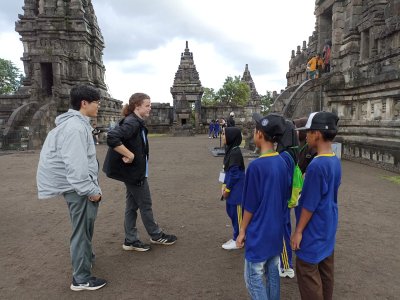


We were besieged by rain– truly besieged. It poured. Most of us sought some refuge under trees or in the temples, but still we were all quite wet at the end. After a quick supper, we returned to the temple complex where we enjoyed the Ramayana story presented in traditional Indonesian dance. It was phenomenal!




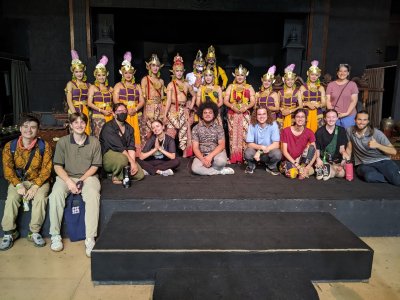
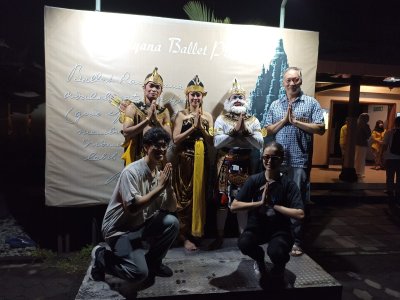
Borobudur is further away, so the following Wednesday (during our last week of study), we left via a 15-passenger van for Mendut village. UIN, the Islamic State University, who is one of our partners arranged the visit for us (thank you!). We checked into our hotel and had a quick lunch. The brave among us tried durian, and most of us ate rambutan. Make sure to ask them if Jonathan, Camila, and Johanna if they liked durian!




After lunch, we headed to the nearby Buddhist monastery, where we were introduced to principles of Buddhist meditation. We tried sitting, laying down, and walking meditation. A few of us even fell asleep during the laying-down meditation (our guide assured us that it was alright if we feel asleep!).


That evening, we attended a Selamatan ritual in the house of our host. This traditional Javanese ritual honors someone who has passed away. In this Selamatan, our host’s parents were being honored. The meal was beautifully served on bamboo platters– it was gorgeous. Unfortunately you’ll have to believe me for that because I don’t seem have remembered to take pictures of the food!

The next morning, some of us woke at 4:00 to greet the sun rising over Borobudur. It was about a 15 minute drive, with a 15 minute hike up the rest of the mountain after that. It was very quiet (unusual for Java), very calm (also unusual), and even a little bit cool! The sunrise was partially shrouded in clouds/mist, but the sight was lovely.


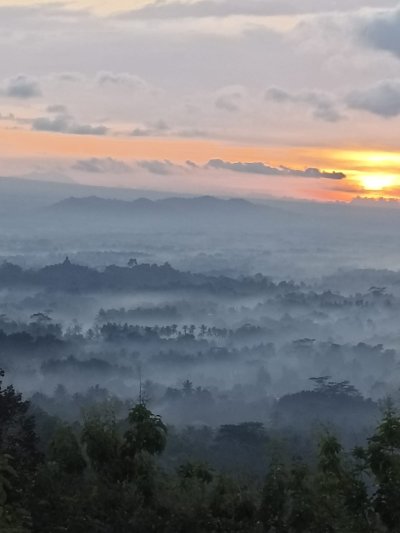





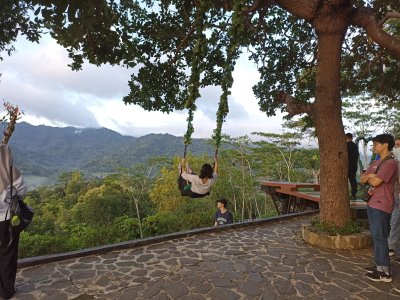


After a stop for a breakfast of fried rice in a little warung owned by Pak Fathan’s sister, we headed back to the hotel to pick up the rest of the students.

And then we headed to Borobudur park! Unlike 30 years ago (and also unlike Prambanan), visitors are limited in order to preserve the temple. Where Prambanan told the story of the Ramayana on the walls around the temple, Borobudur tells the story of the Buddha’s life, from his mother’s pregnancy through enlightment and death.
Enjoy the pictures– I didn’t get as many as I should have, and the ones I do have don’t do this temple justice. It was really beyond words.













